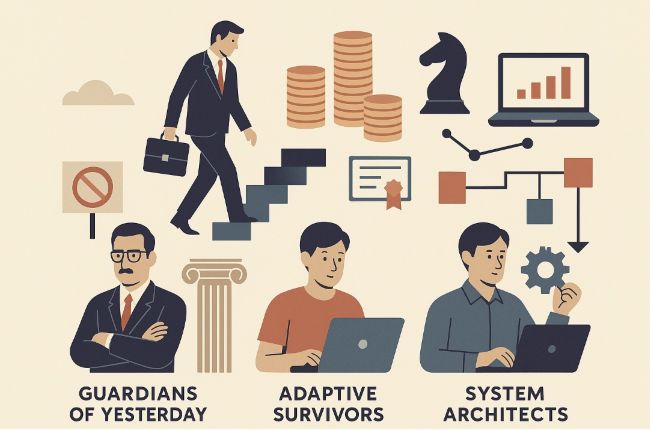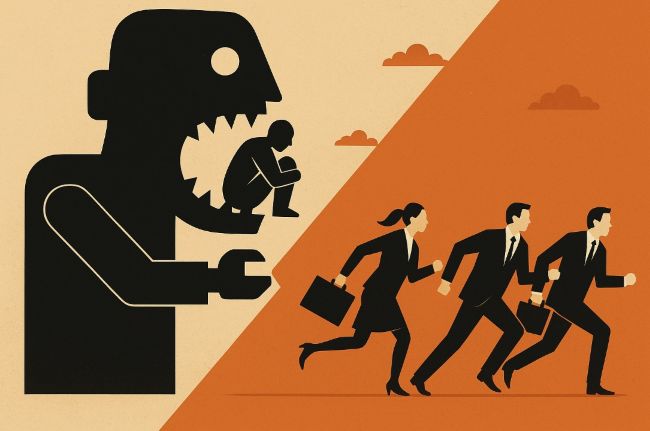How Smart Professionals Are Betting Against Employment
Disclaimer: This article contains speculative analysis about future employment trends. Views expressed are for educational purposes only and do not constitute career or financial advice. Individual circumstances vary—consult qualified professionals before making career decisions.
There’s a mass exodus happening in corporate America that nobody’s talking about.
Not the “Great Resignation” the media covered. Something deeper. The highest performers aren’t leaving for better jobs—they’re leaving the concept of jobs entirely.
What they’ve discovered will fundamentally challenge how you think about your career. Because while everyone debates whether AI will create or destroy jobs, these professionals have realized both sides are asking the wrong question.
The right question? What happens when the entire infrastructure of employment becomes obsolete?
The Pattern History Keeps Repeating (That We Keep Ignoring)
Every time technology reshapes humanity, humans sort themselves into three predictable groups. Not by intention—by instinct.
>> The Guardians of Yesterday
- Their motto: “This too shall pass”
- Their strategy: Protect the status quo at all costs
- Their toolkit: Denial, regulation, protest
- Their outcome: Swept aside by progress
>> The Adaptive Survivors
- Their motto: “I’ll learn the new tools”
- Their strategy: Master just enough to stay employed
- Their toolkit: Certifications, upskilling, compliance
- Their outcome: Perpetual anxiety about the next wave
>> The System Architects
- Their motto: “The rules have changed—time to write new ones”
- Their strategy: Build parallel structures outside traditional systems
- Their toolkit: Leverage, automation, strategic positioning
- Their outcome: Exponential returns on diminishing effort
“You’re either designing the future or you’re being designed out of it”
The Boardroom Conversations They Don’t Want You to Hear
A venture capitalist recently let slip what every investor already knows:
The funding isn’t going toward “AI tools” or “productivity enhancers.” It’s going toward replacement technologies. Not augmentation. Not assistance. Replacement.
The Numbers Tell the Story:
| Industry Leader | Private Statement | Public Impact |
|---|---|---|
| Major Platform CEO | “Every job is on the table—including mine” | Stock price up 40% after automation announcement |
| AI Company Founder | “We’re looking at 20-30% structural unemployment” | $10B valuation on job replacement thesis |
| Top VC Partner | “Why would anyone go to law school now?” | $2B fund focused on professional service automation |
| Tech Influencer | “Our legal spend dropped 80% overnight” | 50K+ executives implementing similar strategies |
Translation: The decision has already been made. The only question is implementation speed.
Sectors Facing Transformation: An Analysis
Investment patterns and industry reports suggest certain sectors may experience significant change:
1. Legal and Compliance Services
- Current observation: Increased adoption of document review software
- Industry reports suggest: Automation of routine legal tasks accelerating
- Potential timeline: Gradual transformation over 2-5 years
- Adaptation opportunity: Specialization in complex, judgment-based work
2. Financial Services and Accounting
- Current observation: Widespread adoption of automated bookkeeping
- Industry reports suggest: AI handling more complex calculations
- Potential timeline: Already underway in many firms
- Adaptation opportunity: Strategic advisory and relationship management
3. Healthcare Administration
- Current observation: Electronic health records and automated billing
- Industry reports suggest: Continued digitization of administrative tasks
- Potential timeline: 3-5 year transformation period
- Adaptation opportunity: Patient advocacy and complex case management
4. Customer Service Operations
- Current observation: Chatbots handling routine inquiries
- Industry reports suggest: Expanding AI capabilities
- Potential timeline: Rapid adoption continuing
- Adaptation opportunity: Complex problem resolution and escalation handling
5. Content Production
- Current observation: AI-assisted writing tools proliferating
- Industry reports suggest: Commoditization of basic content
- Potential timeline: Market shift by 2025-2026
- Adaptation opportunity: Strategic content planning and brand voice development
Note: These observations are based on publicly available market analysis and may not reflect all industry perspectives.
The Three Danger Zones (Is Your Work in One?)
AI doesn’t think about jobs—it thinks about task patterns. Here’s how it categorizes work:
Danger Zone #1: The Repetition Trap
Warning signs:
- Your work follows daily/weekly patterns
- Success = fewer errors, not new insights
- You could write a manual for your job
Examples hiding in plain sight:
- “Strategic” reports that follow templates
- “Creative” work with style guides
- “Analysis” that’s really just formatting
Danger Zone #2: The Decision Tree Trap
Warning signs:
- Your expertise is knowing which rules apply when
- Your value is navigating complexity others created
- A flowchart could represent your thought process
Examples hiding in plain sight:
- “Consulting” that’s really process adherence
- “Advisory” work based on precedent
- “Expertise” that’s actually pattern matching
Danger Zone #3: The Interaction Script Trap
Warning signs:
- Your conversations follow familiar patterns
- You’ve said the same thing 100 different ways
- Your “personal touch” is really just good script delivery
Examples hiding in plain sight:
- “Relationship management” via email templates
- “Consultative selling” through discovery scripts
- “Coaching” using established frameworks
“If you can document it, AI can do it. If AI can do it, AI will do it.”
The Wealth Inversion Nobody Saw Coming
The paradox destroying traditional career logic:
| What’s Becoming Worthless | What’s Becoming Priceless |
|---|---|
| Time-based billing | Outcome-based value creation |
| Process expertise | Pattern recognition |
| Tool proficiency | Tool architecture |
| Information access | Information synthesis |
| Best practices | First principles |
This shift is creating a new type of wealth that has nothing to do with traditional accumulation models.
Hypothetical Case Study:
Based on aggregate market trends:
- Traditional model: $120k salary, 60-hour weeks, corporate role
- New model: $300k+ independent revenue, 25-hour weeks, direct client relationships
- Key change: Shift from time-based to value-based pricing
- Method: Specialized expertise + technology leverage + strategic positioning
These figures represent composite market observations, not guaranteed outcomes.
The Dissolution of the Workplace
Organizations aren’t evolving—they’re evaporating.
The Old Architecture (1950-2020)
Foundation: Geographic concentration of talent
Load-bearing walls:
- Synchronous schedules
- Physical oversight
- Hierarchical approval chains
- Annual performance cycles
- Departmental boundaries
Why it’s collapsing: When individuals + AI outperform entire departments, the architecture becomes absurd
The New Reality: Networked Value Creation
Before: Corporation → Division → Department → Team → Individual → Task
Now: Individual + AI + Systems → Direct Value → Global Market
“Companies are just coordination mechanisms. When coordination becomes free, companies become unnecessary.”
The Acceleration Framework: From Employee to Architect
Four phases to architect your escape:
Phase 1: Perspective Mining
- Stop thinking about skills (everyone has skills)
- Start identifying unique viewpoints
- Ask: “What do I see that others consistently miss?”
Phase 2: Problem Framing
Weak position: “I help with marketing”
Strong position: “I fix the 72% abandonment rate between demo requests and closed deals for vertical SaaS companies”
Precision = Premium pricing
Phase 3: System Construction
- Design once, deploy repeatedly
- Expertise → Methodology → Automation
- Time investment → Asset creation
Phase 4: Value Multiplication
- Stop scaling effort
- Start scaling impact
- Revenue = Value created × Systems built × Leverage applied
The Timeline Already in Motion
Happening Now (Q4 2024 – Q2 2025):
- Professional services: 60-80% margin compression
- Entry positions: Vanishing overnight
- Middle management: Existential crisis
- C-suite: Paying attention
Accelerating Soon (Q3 2025 – Q4 2026):
- Traditional firms: Mass restructuring
- Career paths: Complete redefinition
- Employment contracts: Fundamental reimagining
- Economic models: New categories emerging
New Normal (2027 and beyond):
- W-2 employment: Minority of workforce
- 40-hour construct: Historical artifact
- Retirement planning: Completely reimagined
- Value creation: Fully decoupled from time
This timeline aligns with what experts predict about the next decade.
The Three Paths Forward (Only One Leads Somewhere)
Path 1: The Comfort Trap
- Keep your LinkedIn updated
- Get AI certifications
- Hope your company “figures it out”
- Destination: Displacement with good résumé
Path 2: The Hustle Trap
- Learn every AI tool
- Become “prompt engineering expert”
- Fight for remaining positions
- Destination: Exhaustion with diminishing returns
Path 3: The Architect Path
Week 1-2: Audit Your Danger Zones
- List every task you do
- Mark which fit the three danger zones
- Identify what remains uniquely human
Week 3-4: Extract Your Unique Angle
- Document problems only you notice
- Map your non-obvious connections
- Define your perspective advantage
Week 5-6: Design Your Value System
- Create your methodology
- Build your first leverage tool
- Test with one client
Week 7-8: Execute Your Transition
- Price based on transformation, not time
- Deliver outcomes, not efforts
- Work less while earning more
For executives navigating this shift, adaptive leadership strategies become essential.
The Uncomfortable Truth About Timing
Traditional employment isn’t dying—it’s already dead. We’re just attending a very long funeral.
The Evidence Is Everywhere:
- When departments shrink 80% but output increases
- When juniors aren’t hired but work gets done
- When “strategic initiatives” mean “figure out how to need fewer people”
The Delusion Is Comfortable:
- “My company values its people”
- “My role requires human judgment”
- “AI can’t do what I do”
The Reality Is Clear:
- Companies value outcomes, not people
- Human judgment is pattern recognition
- AI doesn’t need to match you—just be good enough at 1/100th the cost
Potential Future Scenarios
Based on current trends, several scenarios could emerge:
Many professionals are already adapting to these changes.
Observable Patterns:
- Increased freelance and consulting arrangements
- Higher project-based compensation for specialists
- Technology-enabled productivity gains
- Shift toward outcome-based engagements
Market analysis suggests that professionals who combine specialized knowledge with AI tools may find new opportunities.
“Historical precedent suggests that technological shifts create new opportunities even as they eliminate old ones.”
Your Strategic Options
Multiple pathways exist for navigating these changes.
Key considerations for career planning:
- Assess your current skill set objectively
- Identify areas where human judgment remains critical
- Explore how technology might enhance your capabilities
Professional development in the AI era requires thoughtful planning.
Understanding how to navigate this revolution involves continuous learning and adaptation.
Resources for Further Research:
For career exploration:
- Technology’s impact on employment
- Skills development strategies
- Industry transformation analysis
- Professional adaptation frameworks
- Future work models
For strategic planning:
- Career transition methodologies
- Technology integration approaches
- Market opportunity assessment
- Value proposition development
- Professional network building
Remember: The future remains unwritten. While technology will reshape work, human creativity, judgment, and relationships will continue to matter.
Important note: This analysis represents one perspective on potential future trends. Many factors will influence how work evolves, and individual experiences will vary significantly.
Always seek professional advice tailored to your specific situation before making major career decisions.


